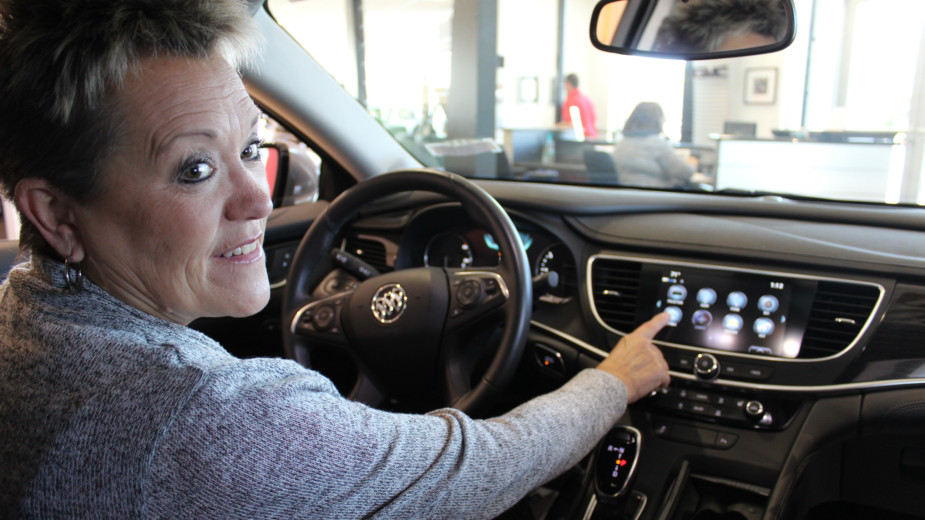Tech Know-How Comes Standard at Dealerships
YOUNGSTOWN, Ohio – Buying a car can induce stress. Between limited-time offers, working through financing, driving from dealership to dealership, picking a model and selecting an options package on that model, the process can be a lot of hassle.
But once all of that is done, says Linda Gabrick, delivery coordinator at Sweeney Buick GMC in Boardman, you can get to the fun part: playing with your new toys.
With all the technology in cars today, it’s Gabrick’s job to make new owners familiar with their cars, from Bluetooth to navigation to music to safety.
“It’s pretty user-friendly, especially as you’re sitting in the car showing it to them and letting them touch the screen,” she says. “It’s a rush to get the deal, get the numbers, get them to finance. This is the relaxing part, the fun part.”
At other dealerships, similar positions are popping up. Two years ago, Cascade Auto Group in Cuyahoga Falls added its first technologist with the sole responsibility of showing customers their cars’ capabilities, says internet manager Pat Primm. Today, the Audi, Subaru and Mazda dealership employs three technologists.
In Warren, all salesmen do the same for their customers when they take delivery of their cars, says Diane Sauer Chevrolet salesman Matt Sauer.
Whatever the title, those who ensure customers are familiar with the technology in their cars often follow the same process. They go through the car’s touchscreen “infotainment” systems, showing them the crucial parts such as navigation, music apps and the address book. If a car has Bluetooth, they link the phone to the car and show customers how to make calls and have them read or respond to text messages. They also show how to activate car-to-sync garage-door openers and set up favorite radio stations.
“As soon as they’re done signing for the car, I take their keys and owner’s manual and sit with them in the car for about 45 minutes to an hour,” Gabrick says. “We start at the steering wheel and go all the way across. I pair their phone and Bluetooth, sometimes make a phone call. I wait to see if they get it. For some people, you can tell they’re not getting it and I’ll back up.”
In some newer models, apps such as Android Auto or Apple’s CarPlay let drivers connect their phones to their cars, turning the central screen into a hands-free version of the phone, down to the app icons that show up.
“It’s full integration that’s designed to keep your hands on the wheel and your eyes on the road. It’s minimal interaction,” Sauer says.
While such amenities are intended to keep drivers focused on the road, there is still cause for concern.
A study done earlier this year by AAA found that a third of drivers use infotainment systems and that drivers who use navigation or messaging apps were visually and mentally distracted more than 40 seconds. Taking your eyes of the road for more than two seconds, the organization warns, doubles the risk of a crash. The study did not say which models tested used hands-free and voice-command systems.
For dealers, teaching drivers how to use their cars’ technologies while they’re still on the lot, and before they drive off, is meant to improve safety.
“We can give every client the talking to and disclaimer, but it’s up to the driver to use as much of it at the appropriate time as they can,” Primm says. “A lot of the technology does shut itself down when the car is moving. In a lot of cars, for the navigation system, you can’t adjust it once you’re moving. On some models you can.”
Among the recommendations the technology specialists at Cascade often make is for buyers to take the time to learn on their own the features they intend to use.
“Sit in your car in the driveway. Play with it,” he says. “There’s no button that’s going to self-destruct your car.”
Beyond just phones and the infotainment systems, technology in cars has grown to include safety measures such as lane keeping, adaptive cruise control and detection of vehicles in blind spots. In the last, some cars offer a light on the wing mirror while others provide a video feed onto the screen. These features, too, are explained and sometimes demonstrated during a test drive.
It’s become standard practice to show all buyers how to use their cars to the fullest. A car isn’t a small purchase and showing customers how to ring those bells and blow those whistles ensures that drivers are not only happy with their cars, but happy with the dealer as well.
“If a consumer doesn’t use his technology within 30 days, there’s virtually no chance he’ll use it at all,” Primm says. “They spend a lot of money with us and put a lot of trust in us, so we want them to get as much out of their car as they can.”
Dealerships offer customers the chance to return later or to give the technologists a call for help. If any questions come up, someone is always on hand to answer it.
“We tell them upfront, ‘Don’t expect to get everything down on your first visit. Just take in as much as you can,’ ” Primm says. “This technologist is going to be here for them, whether it’s two days from now, two weeks from now or two years.”
While showing buyers how to properly use their cars is just good customer service, there’s also a business reason behind it.
“People keep coming back. People have told me they came back because I walked through their car with them,” Gabrick says. “It retains customers because they get a special treatment.”
Pictured: Linda Gabrick, delivery coordinator at Sweeney Buick GMC.
Copyright 2024 The Business Journal, Youngstown, Ohio.


